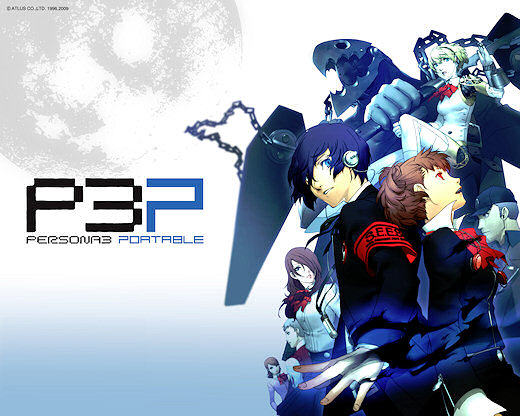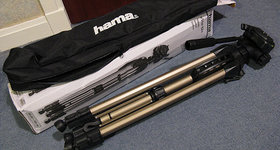Persona 3 Portable Review
Atlus has released a second remake of their popular RPG Persona 3.
Dubbed Persona 3 Portable, the game is based on the first remake Persona 3 FES - The Journey, and brings over all the improvements Persona 4 had to the game system but the biggest change is - Catering for the female fans by bringing in a new Heroine that you can choose to play. So for those of you who played both the original and the first remake on the PS2, is it still worth playing?
For those of you have yet to play Persona 3, the game tells of a group of high school students who have the power to summon beings known as Personas that allow them to fight against some mysterious monsters that appear every midnight, devouring the minds of humans. They don't know why this "Dark Hour" occurrs and why they're the only ones that can move during this time but, they intend to find out and believe the tower that appears, "Tartarus" is the key to it all.

Gameplay
The main parts of the game very much remains the same as the original but as I mentioned earlier, lots of changes that were made to the gameplay system in P4 have been brought over. There's so many in fact I won't list them all but focus on the main changes that I feel make some significant difference.
During the day you're busy attending school and working on your relationships with others which in turn, strengthens the Personas you create and give you a little experience of what a dating sim feels like. Playing as the Heroine changes the way people talk to you of course and there's two new female Social Links added. New part time jobs now give you alternative means of earning money and makes leveling those social stats easier just like in P4.
What clearly has changed right from the start of the game is that you can no longer run around the world of Port Island in 3D. Instead, you have a series of icons (which can be turned off) that you move a cursor to interact with characters and other objects. It's a shame because not being able to see everything from different angles just detracts that exotic environment the original had - at least for Western fans anyway.
Then at night, you're exploring Tartarus and fighting Shadows. Each Shadow has their own elemental or physical weaknesses you can exploit to make quick work of them. You still explore the same way, climbing up the randomly generated floors until you reach the next boss but they've decided to make the game easier by not letting your party members get tired while you're in the middle of exploring a dungeon. It's only after you return to the ground floor they grow tired now which means beating sections of Tartarus is much easier than before. Not to mention there's lots of other ways to heal up and you can command party members directly too now although by default, they are still controlled by AI.
Also, with a second analog stick "missing" on the PSP you're stuck with using the L and R buttons which feels a little awkward because the rotating action doesn't feel quite as smooth. Anyone who played the game twice already can hold the triangle and circle buttons together to speed through the text - an option very common with visual novels.
Apart from two new Social Links when playing as the Heroine, you also get something called the "Vision Quest" towards the end of the game which lets you fight all the main bosses again with different conditions. Your party members, equipment and Personas you can use are all pre-selected and the the bosses prove to be much stronger with new tricks up their sleeves such as constantly changing weaknesses so you can be sure they're quite a challenge even to veterans. And if Elizabeth wasn't challenging enough to beat, you now have a chance to fight her older sister Magaret from P4 too.
Presentation
Right from the start of the game, you'll notice that all the videos and 3D environments have been stripped out of the PS2 game and have been replaced by slideshows and still backgrounds instead. Not only that, the image quality shows a lot of lossy compression which suggests Atlus may have just captured these as screenshots instead of re-rendering them from the originals. The characters on the maps are also tiny so some minus points here.
The main scenes are no longer acted out by 3D models of the characters and are replaced by portraits instead much like that of a visual novel game - Just screen after screens of text instead of watching a show fold out as in the original which gets kind of tiring instead of say, witnessing a character fall to his/her knees after being fatally wounded or the only exit slamming shut. Or just Yukari having trouble pulling the Evoker's trigger right at the beginning of the show even.
That said, if you don't mind enjoying the story like an audio book, it's still pretty enjoyable. We also do have a number of new portraits that show a little more detail and expression than the original such as a Shadow victim having black blood oozing out of his head.
At least with visual novels, key event scenes have a unique rendered illustration to look at whereas here it's all just sound effects. If I hadn't played the original game I doubt the story would still have as much impact.
Fortunately, the ending still keeps its impact.
Tartarus on the other hand still looks good with everything still in 3D complete with any costume or weapon changes reflected visually. Persona models also look great.
Music wise it's again very much the same. The inclusion of the new Heroine only adds in 7 new tracks from Meguro so don't expect too much. It's good to see you that the game alternates between the new opening "Soul Phrase" and the original "Burn My Dread" when loading up the game though - Just wait at the title screen for a while.
Summary
Persona 3 Portable is very much the same as Episode Myself but with all the improvements brought over from P4 (most notably being able to give commands directly to party members), the game is easier to play on the move. The compromises made to the presentation degrades the overall atmosphere the original game had - especially when they are grainy and show signs of lossy image compression. Most of the time it feels like a badly presented visual novel or audio book even.
As someone who played the original game, I would say it's worth playing if you want to experience the game again with the improvements to its system or just the new S. Links the new Heroine offers. Otherwise, "Vision Quest" alone provides very little new content for a third play through unless you want the game with a whole new difficulty level.
Time Completed 45 hours
Good
- Command party members directly.
- Part time jobs raise more than one social stat.
- Tiredness no longer prevents you exploring Tartarus in one go.
- A calendar to keep track of events.
- New "Vision Quest" boss fights prove quite a challenge.
- Keeps the smooth weakness exploitation of the original game.
- Original "Burn My Dread" opening kept.
Bad
- 3D environments and video cutscenes replaced by slideshows.
- Story part feels more like an audio book.
- Not that much new content for its third iteration.



White Asuka
Xcomp Author
NOOB
Smartguy05
Xcomp Author
Yeah, you fight him instead of Elizabeth if you choose him when playing as the Heroine. In terms of personality, I think he's the more sensitive type when he's not putting on the formal face...?
@Smartguy
Never used her. Just stuck to the members that were available from the start of the game this time.
Smartguy05
UmiMizuno